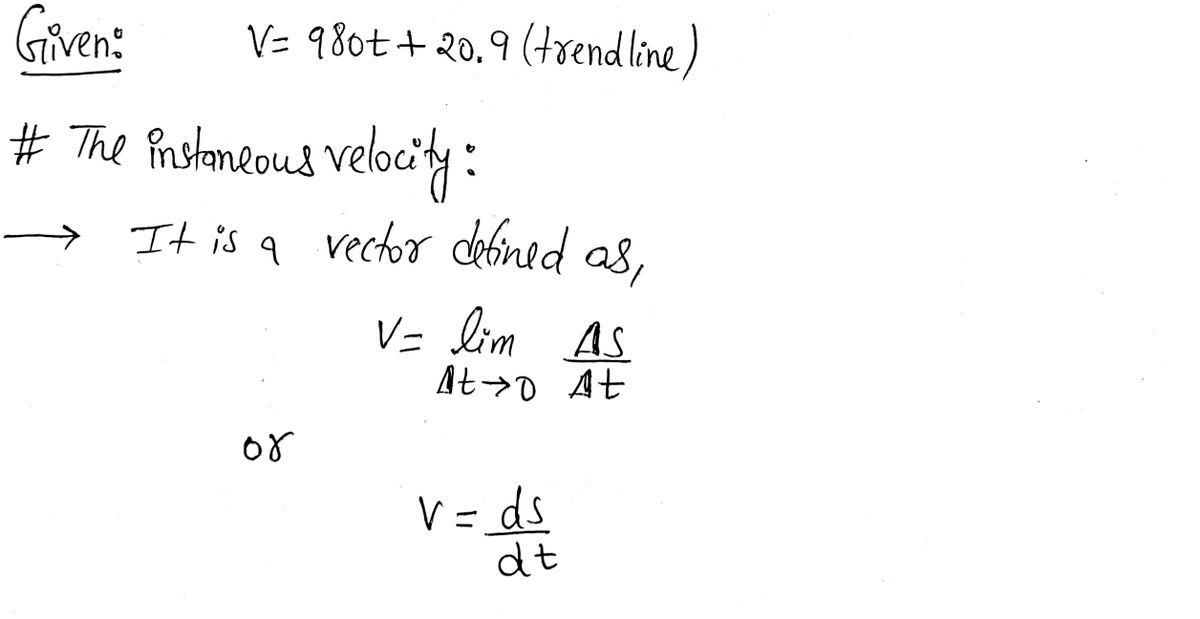How do you calculate the instantaneous velocity from a velocity vs time graph? Eg. From the image below, Calculate the instantaneous velocity of V(4) at t(4),etc.
How do you calculate the instantaneous velocity from a velocity vs time graph? Eg. From the image below, Calculate the instantaneous velocity of V(4) at t(4),etc.
Elements Of Electromagnetics
7th Edition
ISBN:9780190698614
Author:Sadiku, Matthew N. O.
Publisher:Sadiku, Matthew N. O.
ChapterMA: Math Assessment
Section: Chapter Questions
Problem 1.1MA
Related questions
Question
How do you calculate the instantaneous velocity from a velocity vs time graph?
Eg. From the image below, Calculate the instantaneous velocity of V(4) at t(4),etc.

Transcribed Image Text:The graph titled "V(ave) vs. t" displays the relationship between average velocity (V(ave)) and time (t). The horizontal axis represents time (t) in seconds, ranging from 0.1 to 0.4. The vertical axis represents average velocity (V(ave)), with values ranging from 0 to 500.
The data points on the graph are plotted at four different times:
1. At t = 0.1, V(ave) is 122.1.
2. At t = 0.2, V(ave) is 213.7.
3. At t = 0.3, V(ave) is 311.7.
4. At t = 0.4, V(ave) is 416.2.
These points have been connected with a straight line, indicating a linear relationship between average velocity and time. The line of best fit is described by the equation: V(ave) = 980*t + 20.9, where 980 is the slope and 20.9 is the y-intercept.
This graph is useful in illustrating how average velocity increases linearly over time.
Expert Solution
Step 1:

Step by step
Solved in 2 steps with 2 images

Recommended textbooks for you

Elements Of Electromagnetics
Mechanical Engineering
ISBN:
9780190698614
Author:
Sadiku, Matthew N. O.
Publisher:
Oxford University Press

Mechanics of Materials (10th Edition)
Mechanical Engineering
ISBN:
9780134319650
Author:
Russell C. Hibbeler
Publisher:
PEARSON

Thermodynamics: An Engineering Approach
Mechanical Engineering
ISBN:
9781259822674
Author:
Yunus A. Cengel Dr., Michael A. Boles
Publisher:
McGraw-Hill Education

Elements Of Electromagnetics
Mechanical Engineering
ISBN:
9780190698614
Author:
Sadiku, Matthew N. O.
Publisher:
Oxford University Press

Mechanics of Materials (10th Edition)
Mechanical Engineering
ISBN:
9780134319650
Author:
Russell C. Hibbeler
Publisher:
PEARSON

Thermodynamics: An Engineering Approach
Mechanical Engineering
ISBN:
9781259822674
Author:
Yunus A. Cengel Dr., Michael A. Boles
Publisher:
McGraw-Hill Education

Control Systems Engineering
Mechanical Engineering
ISBN:
9781118170519
Author:
Norman S. Nise
Publisher:
WILEY

Mechanics of Materials (MindTap Course List)
Mechanical Engineering
ISBN:
9781337093347
Author:
Barry J. Goodno, James M. Gere
Publisher:
Cengage Learning

Engineering Mechanics: Statics
Mechanical Engineering
ISBN:
9781118807330
Author:
James L. Meriam, L. G. Kraige, J. N. Bolton
Publisher:
WILEY